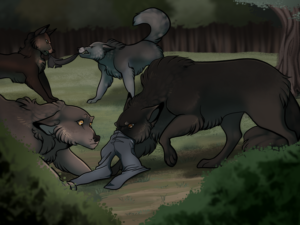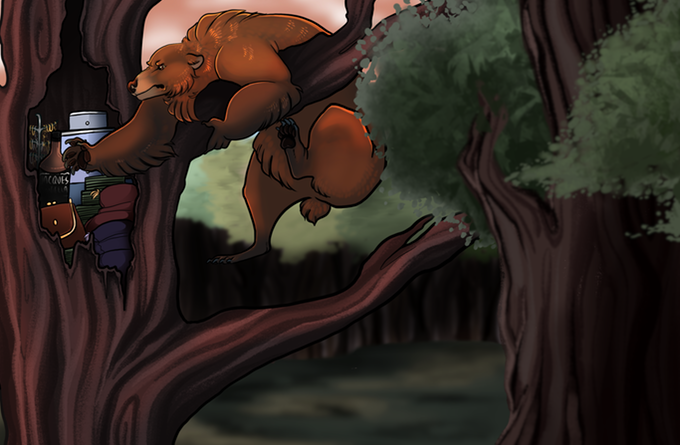An Interview with Brie Beau Sheldon of Turn: A Tabletop Roleplaying Game
I was given the chance to talk with Brie Beau Sheldon, creator of the new RPG Turn, which is live on Kickstarter right now. What is turn? From their Kickstarter:
Turn is a slice-of-life supernatural roleplaying game about shapeshifters in small, rural towns who struggle between their beast and human sides in a quiet drama, while trying to find balance and community.
I’m really intrigued by this, so I spoke to them about the game and its influences:
Tell me about Turn. Where did you come up with the idea?
“Turn’s conception was a process. The idea to make a game that was meant for me came from feeling less than satisfied while playing other games, ones that were more intense and dramatic or included more viciousness, and the idea for shapeshifters and small towns were really just “I like shapeshifters a lot, and I like small towns a lot, and maybe if you put them together… *insert smashing things together here*” I used a fair bit of destructive design to work on some of the early mechanical decisions – taking apart other games (Monsterhearts, primarily) to figure out what parts I liked and didn’t. The game doesn’t function at all like anything from the early destructive design process – so it worked!”
What real-world influences are you pulling from?
“Real world influences I suppose include my own experiences living in small rural towns! I grew up in three small rural towns for varying lengths of time, the first was technically populated around 3000 people but on the road we lived and that I repeatedly stayed with my grandparents in, it’s not even big enough to be recorded. Just one road, but it was its own little place. I then lived in an area that, I kid you not, was called Boggsville, and the population of the town itself was in the hundreds, but it’s not recorded well. Finally I lived outside of the first successful planned industrial town, but technically I lived in a village outside of it, which was basically just like the people who lived along a specific road. It was another place where the larger township had around a population of 3000, but the actual village isn’t even recorded. And it’s that – this existing while being isolated, existing while not really being on anyone’s radar, meanwhile we were farming and living just like everybody else. Small towns are different, with these weird boundaries that aren’t even sometimes real, and relationships that are so complicated and filled with legacy even if you’ve only lived there a bit. Everyone knows everyone, but there are secrets that we often couldn’t even dream of.”
There’s also just my experience as a person with a secret – as a queer, nonbinary person in a small town, even when I didn’t have words for what I was, I was still harboring that. It’s hard not to think about my identity when I write for Turn, when I play it, because it’s about identity. It’s just about a different kind of identity!
I did also consult with some people with different experiences and backgrounds than me, but Turn is at heart a relatively simple game, and unfortunately there aren’t a lot of media touchstones I’ve been able to fall back on. There are probably some implicit concepts in my work, but I made an effort to avoid referring directly to any myths or historical sources to avoid appropriation.”
How long has the game been in development?
“Turn has been in development since 2013, conceived with kind of loose notes and continued revisiting until I wrote down clear base mechanics in 2016. Since then I’ve added a little, clarified things, and adjusted as playtests called for, but the roots remain the same.”
How did you develop the game mechanics?

“So I talked a little bit about the destructive design, which is basically the name I give the way I do design that I figure is something a lot of people do. I take mechanics, settings, concepts apart and identify key elements and functions – the nuts and bolts, if you will. I put it back together if it works for me, otherwise I take pieces out and use what I like. This is why Turn doesn’t have failure like many games, but does have a Powered-by-the-Apocalypse-
I did a fair bit of playtesting in the latter half of the design phase, but the first three years of work was mostly brainstorming, mock playtests (basically playtesting by myself), and so on. I was too afraid to tell anyone about the project because I thought it would just suck. Eventually I spilled the beans to my business partner/husband-man John W. Sheldon and he helped me start writing things down, playtesting, and making it happen.”
How does a standard session play? The Kickstarter speaks of creating a town and regular world struggles interacting with your supernatural life. What would a session look like?
“There’s a standard session checklist that includes beast and human scenes with PCs and NPCs, the gossip phase, and mundane/rumor-related vignettes. An average session can vary a lot! Each campaign begins with building a town together, then introducing some narrative rumors to help push the story along. After that, you engage with those scenes in the checklist, which can present as any number of experiences. In one scene tonight, a Snake shifter and a Raccoon shifter were out on the marina in their small town giving each other challenges – the Snake challenged the Raccoon to hook a half a burrito on the fishing hook of a deep-sea fishing rod someone had left propped up on the dock, and the Raccoon challenged the Snake to swim up a sailboat mast and tap the top. They both accomplished their challenges, but the Snake broke a line on the way down and caused a ruckus!
In human form, we’ve had scenes that were very simple conversations, but also more stressful ones. Like in a game I had the other night where a shifter had been at a nearby lake, in cougar form, searching for something. It made them late for their day job, and when they showed up, their boss kept pressuring them for information, asking them where they were. They ended up acting really cold toward their boss, and revealing a bit of their supernatural identity, and their boss made some assumptions about their whereabouts that were thankfully inaccurate but potentially troublesome in the future!
A lot of play is just people doing normal things, real life things, in beast and human form, and telling the stories that might be less interesting if their other identity wasn’t waiting for the opportunity to take charge.”
What draws you to shapeshifting narratives?
“Some of it is simply fun! I like the idea of having superpowers, and being able to live some of my life as an animal in the wild sounds pretty amazing. But, I also deeply understand the nature of having multiple parts of who you are. I have bipolar disorder, so having a more muted, down side of me and a more hyper, intense side of me is fully real. And as I said earlier about queer and nonbinary identity, the idea of having parts of you that you have to keep secret, or that you have to hold back? That’s totally something I understand, and seeing a fictional, supernatural kind of identity crisis and struggle is appealing. It maybe abstracts it enough for me to really be able to play it out and enjoy it without feeling triggered or struggling with my own self.
But admittedly, a heck of a lot of it has to do with how cool it sounds to be able to turn into something completely different and experience life in a totally new way!”
Thanks for the interview! If you haven’t already, definitely go check out the game, which is also being worked on by my friend Tracy Barnett.

